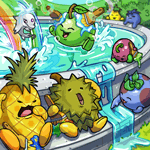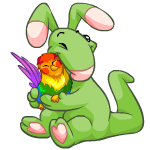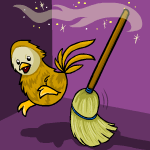 975 Mysteries of Neopia: The Chia Edition
by redpirate21
--------
The world of Neopia, vast and diverse with its rich and vibrant history, is home to Neopians and Neopets alike. There are over 50 species currently known, and doubtless more to be discovered in the unknown land far-away from even our wildest imagination. The story of how each species came to be is a mystery, but none other than the Chia. Scouting the intensive and vivid libraries all over the continents, from the land of the Faeries to the underground network of Moltara, we can immerse ourselves in the knowledge of the past and relive the momentous turning points that make Neopia how it is today. But when it comes to the history of each Neopet species, little information is known. Have you ever wondered how your beloved Neopet survives in the wilderness before you come along? Though there are meagre official resources regarding this account, we can speculate quite accurately based on their anatomies and behaviours. While the 55 currently known Neopets species are very diverse, we can attribute their evolutionary success and survival ability based on a handful of factors: size, strength, speed, intelligence and social tendency. Certain species like the Chomby, Elephante, Skeith and Grarrl rely on their massive stature to intimidate and fend off attackers. Moreover, the Elephante’s trunk and the Grarrl’s jaw can inflict significant damage at close range. Being predominantly herbivores, the Chomby and Elephante also adopt social structure in large groups for the benefit of safety in number. Many species prefer to take to the sky. The Buzz, Korbat, Pteri and Shoyru are average in size with naturally limited fighting and defensive capability. Their evolutionary success owes a big part to their ability to avoid conflict by flying. While Eyries and Draiks can fly, they will stand their ground if threatened: Draiks are known for their formidable tail whip and Eyries with sharp talons and beaks. While Lenny, Uni, Gelert and Xweetok cannot fly, their speed and intelligence will easily outmatch attackers if underestimated. The Lenny and Uni can also deliver powerful kicks in a pinch. Gelert and Xweetok both have superb senses of hearing, allowing them to escape predators long before they become a threat. Many species don’t specialize in any attribute but rather prefer being a jack of-all-trade with average size, strength, speed and intelligence that adopts large social structure. This group encompasses the Acara, Aisha, Ixi, Kau, Kyrii, Moehog, Ogrin, Wocky and some aquatic species like Flotsam, Koi or Tuskaninny. Little is known about the Vandagyre, the most recently discovered species. Experts generally agree that Vandagyre is social and highly intelligent but lacking in other qualities. Interestingly, on the other end of the spectrum, some species with inferior attributes such as the JubJub and Kiko also thrive in Neopia, with the latter being especially adapted to the region of Kiko Lake, aptly named after the numerous Kikos populating the area. While the Kiko only has two arms, the JubJub only has two feet. The limited number of limbs certainly is a big disadvantage when it comes to surviving in the wild. The Kikos, being mostly confined to the aquatic environment of Kiko Lake, rely on their arms for swimming. The JubJubs, generally considered slightly more successful than the Kikos, have a wider habitat range. Some experts argue that JubJub originated from Neopia Central, the most forgiving land in all of Neopia. No matter their origin, today JubJubs have ventured into the more distant corners with some progress. Notably, their small size and round body shape allow them to roll down mountainous terrains to escape predators, conserving energy for other tasks. If threatened, they can let out a loud deafening shriek. In summary, this analysis is by no means an exhaustive list of attributes that define the success of the 55 currently known Neopets species. The diversity has made it very challenging for experts to put an emphasis on any one factor alone for their prosperity. In fact, it’s commonly agreed that no species fits a pre-existing mold, the prime example is none other than the Chia. At first glance, the Chias are clumsy with short, chubby arms, legs and no threatening physical features. Their modest size, strength, speed and intelligence make them easy targets for predators. While being cheerful and social make them great beginner Neopets, it is particularly puzzling how this species survives the test of time alongside many formidable predators. In fact, the Chia is the favourite snack for the Lupe, a mid-size hunter. Similar to the JubJubs, the Chias originated from Neopia Central, but unlike the JubJubs who prefer mountaintops and the Kikos who excel in aquatic habitats, the Chias have no specialised quirk that lets them shine in any niche. It is even more surprising that the Chias’ one unique trait is the fact that they can turn into vegetables, an ability that seems to be at odds with survival. While some colours provide excellent survival bonuses such as flying (Faerie), swimming (Maraquan) and camouflage, being a vegetable has no obvious advantage. Neopian scholars have argued over this phenomenon for centuries. The most plausible theory to date has been drawn by comparing the Chia with the Grundo. While both share striking similarities regarding morphology, the Grundo’s native homeland is Kreludor/Virtupets station. Possessing short, chubby arms and legs with two antennae on its head, the Grundo shares humble attributes that would also make them easy prey for even the most amateur hunter. Their prosperity, ironically, owes largely to Dr. Sloth who kidnapped a large population of Grundos from their ancestral homeland and forced them to work under him. It is a mystery where he kidnapped them from. The only clue from the official record was the word “Doran”, which might be the planet of their origin. To explain their non-threatening physical traits and subpar attributes, scholars have suggested that no predators live on Doran, a theory that is as implausible as the Chia itself. Nevertheless, nowadays Grundos can be seen roaming all over Neopia, usually under the protection of their owners. The success of the Grundo as an established species is an unusual one, with Dr. Sloth as the primary catalyst. Perhaps the story of the Grundo can help us better understand the Chia. Scholars have argued that an external factor must have occurred to ensure the prosperity of the clumsy Chias that we’ve all come to love. A popular theory is linked to their vegetable-like body shape: farmers all over Neopia use Chias as pets to better care for their plants and vegetables. It is believed that a Carrot Chia, for example, thrives in the same conditions that a carrot would. If the Carrot Chia is in distress, then the carrot will soon deteriorate. Farmers can observe changes in the Chia to sense or predict disease, decay and rot on the field. In turn, the Chia is provided food, shelter and protection. This theory has gained great traction among Neopians. In fact, Chia is one of the most popular species among farmers. Today, these awkward vegetable-like creatures can be seen from the great Terror Mountain to the depth of Maraqua. However, sceptics have commented on the fact that if this theory was true, how come the relationship between Chias and farming had not been documented in the past? Why did historians overlook such an important phenomenon? The closest insight is from the book “A History of Chias”, which, unfortunately, only gives us “a complete listing of important Chias throughout the history of Neopia” and does not explain why Chia is an accomplished species despite its obvious lack of offensive or defensive capability. Learning more about plants and vegetables might give us clues about the Chia’s secret. After all, if a grape can survive the test of time, so can a Grape Chia, right? The world of Neopia holds many fascinating mysteries. Each Neopet species carries an extraordinary tale that echoes with every footprint, painting a remarkable journey through the passage of time. Hidden in each one is a story waiting to be unearthed and celebrated. No matter how big or small, fast or slow, peaceful or aggressive, from the Kougra’s ferocious roar to the Cybunny’s energetic hop, there is so much for us to learn and unpack. One day, perhaps in the near future, we will discover the Chia’s secret. What do you think it will be?
| |
|
Search the Neopian Times
Great stories!
---------
---------
 Does Your Weewoo Love You? Does Your Weewoo Love You?
"With this 10 question long quiz you can quickly figure out if your warm and fuzzy feelings for your Weewoo are reciprocated or not"
by iwonder |
---------
---------
 Magic Quill ∗*⊹ Magic Quill ∗*⊹
Magic is just as unpredictable as getting published into the 975th issue Collab with industrial
by praline01 |
|
|